Release News Dokumente
Go2signals 24.2 Go2signals 24.1 Go2signals 23.2 Go2signals 23.1 Go2signals 22.2 Go2signals 22.1release news – Go2signals 24.2
SIGNAL ANALYZER ENHANCEMENTS
NEW: TEMPLATE OQPSK ANALYSIS
This template adds additional measurement features specialized on OQPSK modulation analysis. The template includes spectrum of multiple squared signal analysis with marked positions of expected peaks, OQPSK adapted symbol rate measurement, frequency correction analysis for absolute IQ displays, difference phase histogram analysis and absolute and difference IQ displays.
Outstanding is the new feature absolute IQ display of even and odd symbol to check the signal against QPSK signals without any symbol offset.

New template for OQPSK modulation analysis, containing special analysis functions
New: TEMPLATE SQUARED SPECTROGRAM
During a transmission PSK modulated signals often change their valence (e.g. from 2 to 4 or 8). With this new template including signal squaring and spectrogram analysis it is easy to check for this behavior. As this is a typical behavior of some known communication signals, it is relatively straightforward to identify them with a high degree of reliability.

New template Squared Spectrogram, e.g. Maritime Mesh Network burst starts with 2PSK modulation, changes to QPSK and ends with 2PSK
NEW: PRE-PROCESSING MODULE DECHIRP
This pre-processing module allows to demodulate (“un-chirp”) signals using a linear frequency chirp modulation (up or down). With a single keystroke, a new analysis window starts using the demodulated result as input signal. In this way, it is possible to do a full featured analysis for an in-chirp modulation if present.

Analyzing a Codan-Chirp sync burst
From left to right:
• Spectrogram of the input signal, selection of the analysis signal range
• Zoom spectrogram with high time resolution showing the chirp modulation
• Spectrogram and instantaneous frequency of the un-chirped signal
ENHANCED: MODULE SYMBOL RATE
The generic measurement module “Symbol Rate” provides various methods for symbol rate estimation. This module is now enhanced with spectrogram analysis to show symbol rate behavior in time.
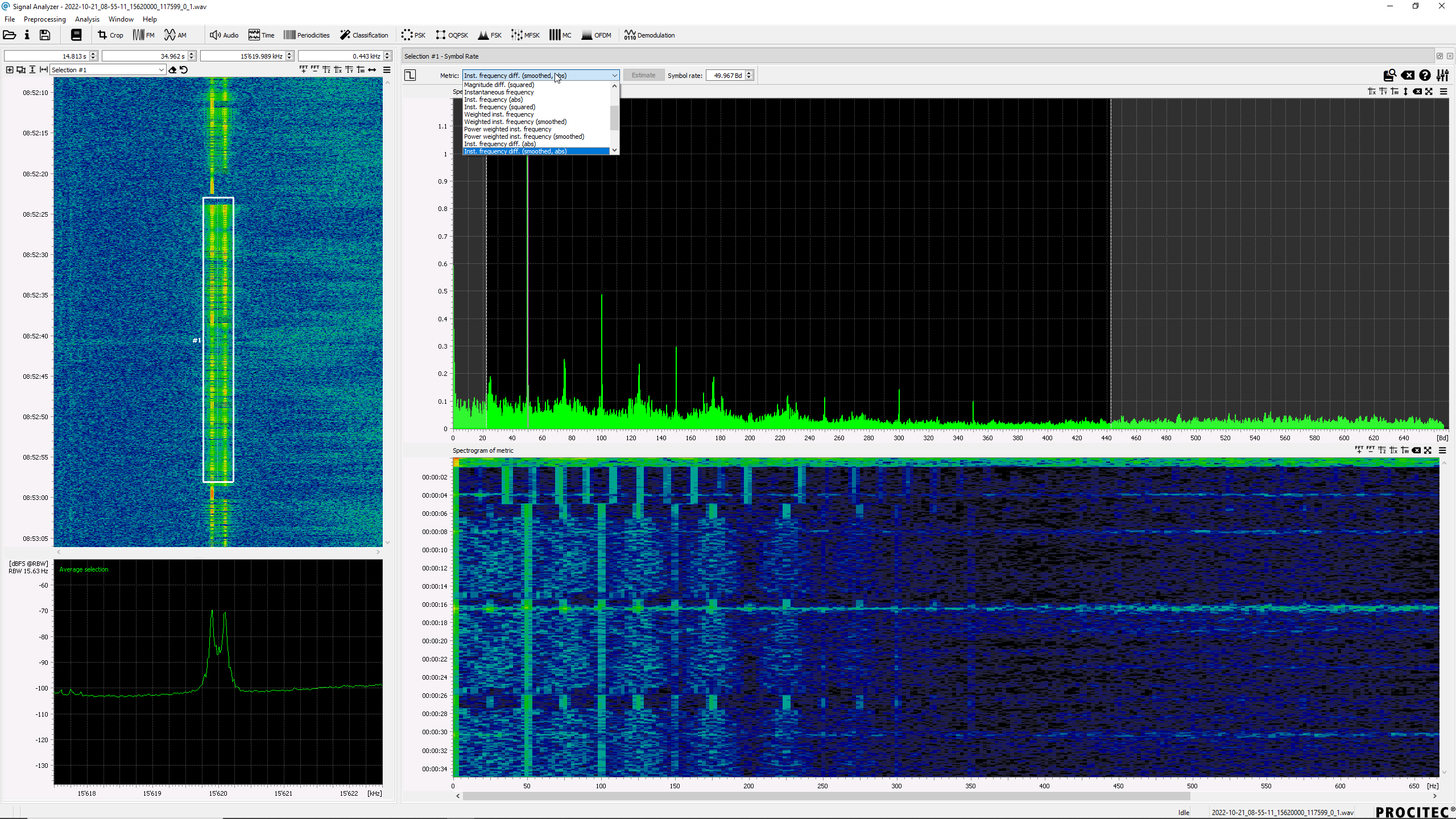
Generic module for symbol rate analysis, e.g. CIS 36-50 syncs with 36 Bd and changes up to 50 Bd
Go2MONITOR ENHANCEMENTS
ENLARGE WIDEBAND INPUT BANDWIDTH
go2MONITOR 24.2 now supports the full input bandwidth. The software is only limited by the hardware performance available (e.g. receivers, drivers, CPU performance, memory amount/speed, etc.). Maximum supported range is up to 200 MHz.
Wideband Classifier bandwidth starts from 1 MHz (HF) and 5 MHz (VUHF) with the default license, increasable with option WCL-10 up to 10 MHz (1 MHz HF) or with option WCL-20 up to multiple times of 20 MHz (2.5 MHz HF).
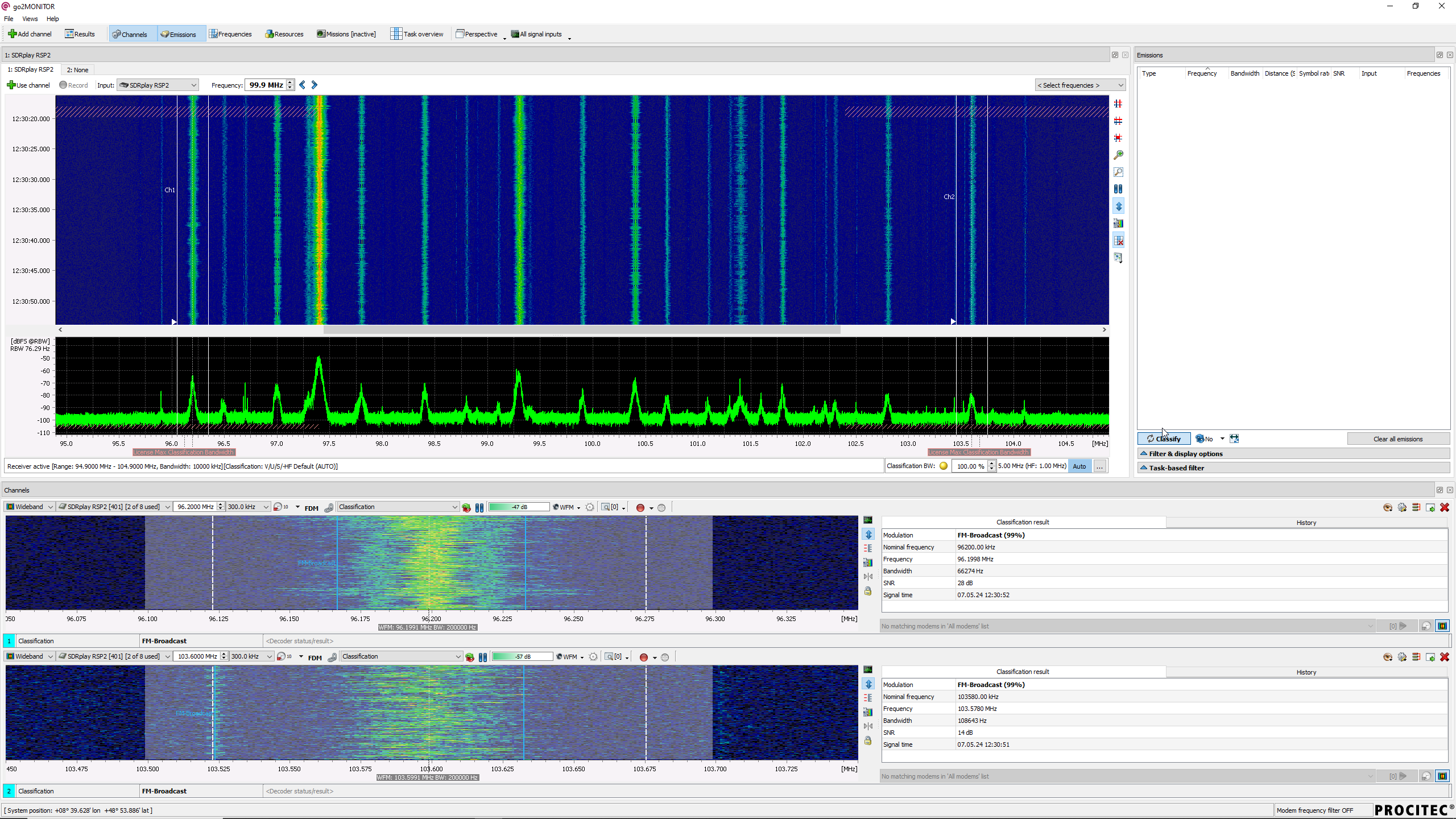
E.g. operate complete receivers input band of 10 MHz with a default license on a standard laptop hardware. Wideband classifi er works on 5 MHz as maximum
NEW WINDOW LAYOUTS WITH ENHANCED DOCKING WINDOWS
The layout in go2MONITOR can be set in any way you want, simply by docking and undocking its windows. This new release gives users more flexibility than ever to customize the layout to their personal needs
Dragging a window small icons appear showing the possible docking positions
NEW EMITTER TRACKING FEATURES
With go2MONITOR, you can not only receive signals and decode their content, but you can also further evaluate the results and view, edit or discard them before exporting them. To extract the data like position data, the software has a post processor feature running after the signal was received, extracting sender and receiver IDs, position data, and more. For ADS-B signals, the post processing was adapted to extraction airplane positions and their addresses send:

Extract positions and addresses from a decoded ADS-B signal
Combine and display the position data from a moving emitter as a track on the map.This function is available for all signals (modem types) with position data. If available, decode the position data directly from the signal or receive it from a connected positioning system.
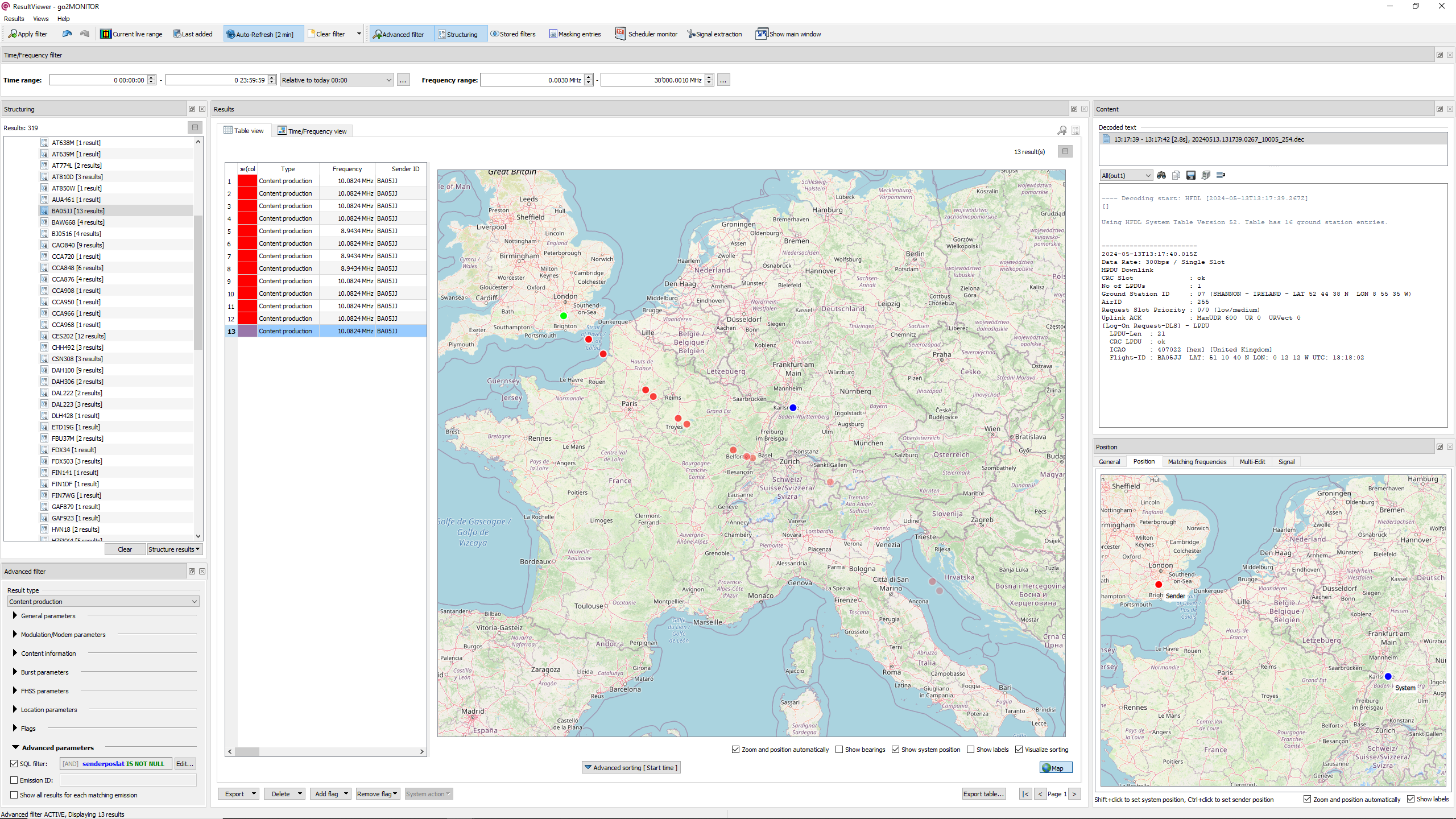
Flight path of an aircraft (older data is displayed in lighter red). Positions are decoded from its HFDL signal
New automatic task option to limit the number of channels which are used by the task. With this simple parameter the operator can optimize resource usage between different task running in parallel.
SOMO ENHANCEMENTS
NEW: OUTPUT SAMPLING RATE NOW CONFIGURABLE
SOMO now includes a new feature that allows you to confi gure the output sampling rate. This increases the output bandwidth of the signal generator by up to 10 MHz, depending on the hardware used.
For example, live generating and streaming of a signal scenario containing five QAM16 modulated signals with different symbol rates in a 5 MHz band. With go2MONITOR, the scenario is classified in the wideband input and in a selected channel.
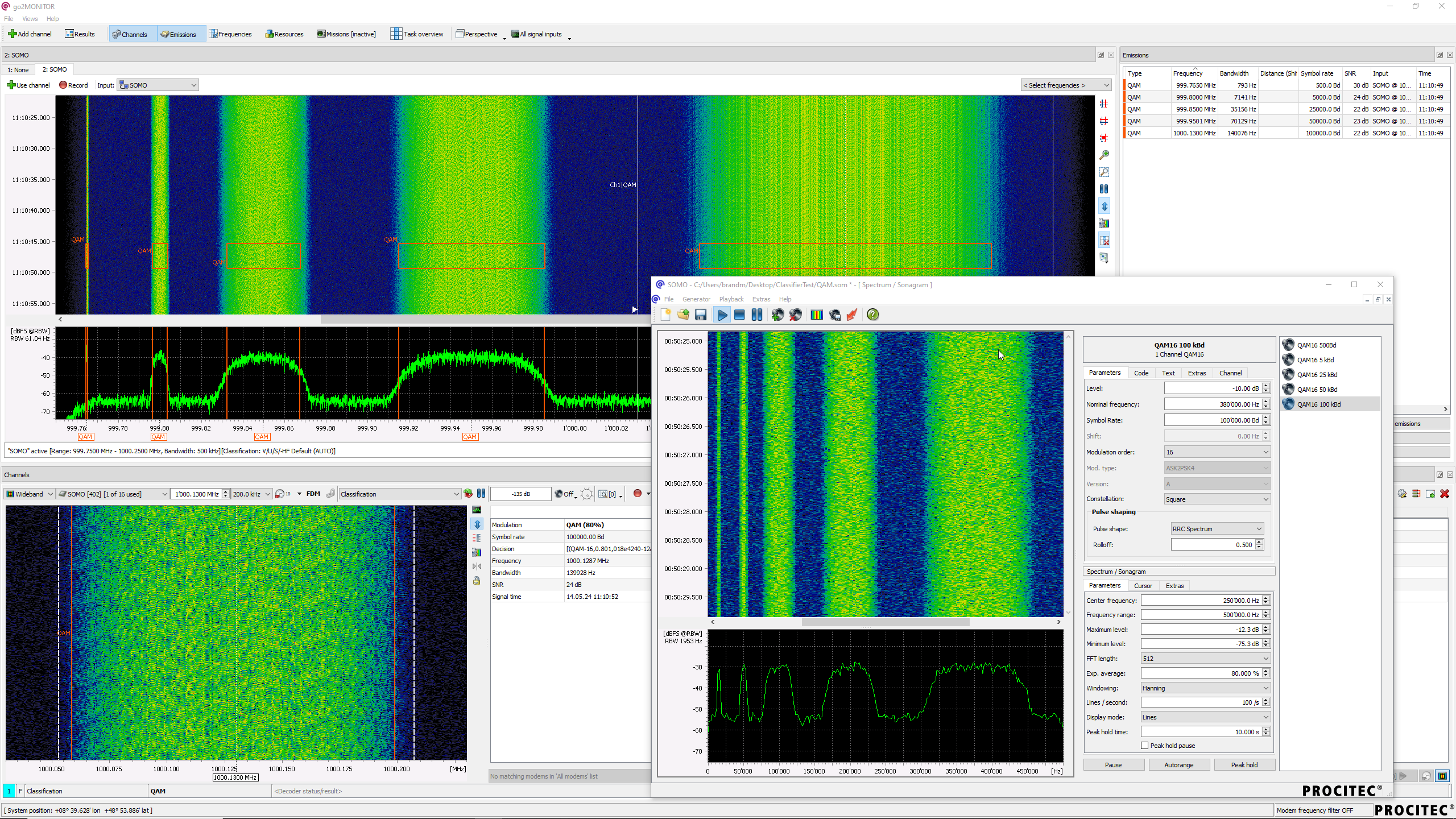
Using SOMO for testing and training with live streaming of complete signal scenarios
CLASSIFIER ENHANCEMENTS
The go2signals software offers one of the most comprehensive modulation classifiers on the market. The signal parameters obtained are primarily used for fi ltering according to Signals of Interest (SOIs), but also for recognizing unknown, new signals in both, narrowband and broadband input types. As in previous releases, we have also increased the bandwidth for our classifier for additional signals. In this release for QAM modulation.
Main release changes:
- Enhance classification of QAM 8, 16, 32, 64 signals up to 12.5 MBd
- New classifier for FM-PSK 2, 4, 8, 16 primary modulated PSK signals

Classifification of a FM-PSK modulated signal
DECODER AND DEMODULATOR ENHANCEMENTS
One of the core functions of the software is demodulation and decoding. In order to remain at the cutting edge of technology, the number and functions of these components are constantly being expanded. This is also the case with this new release.
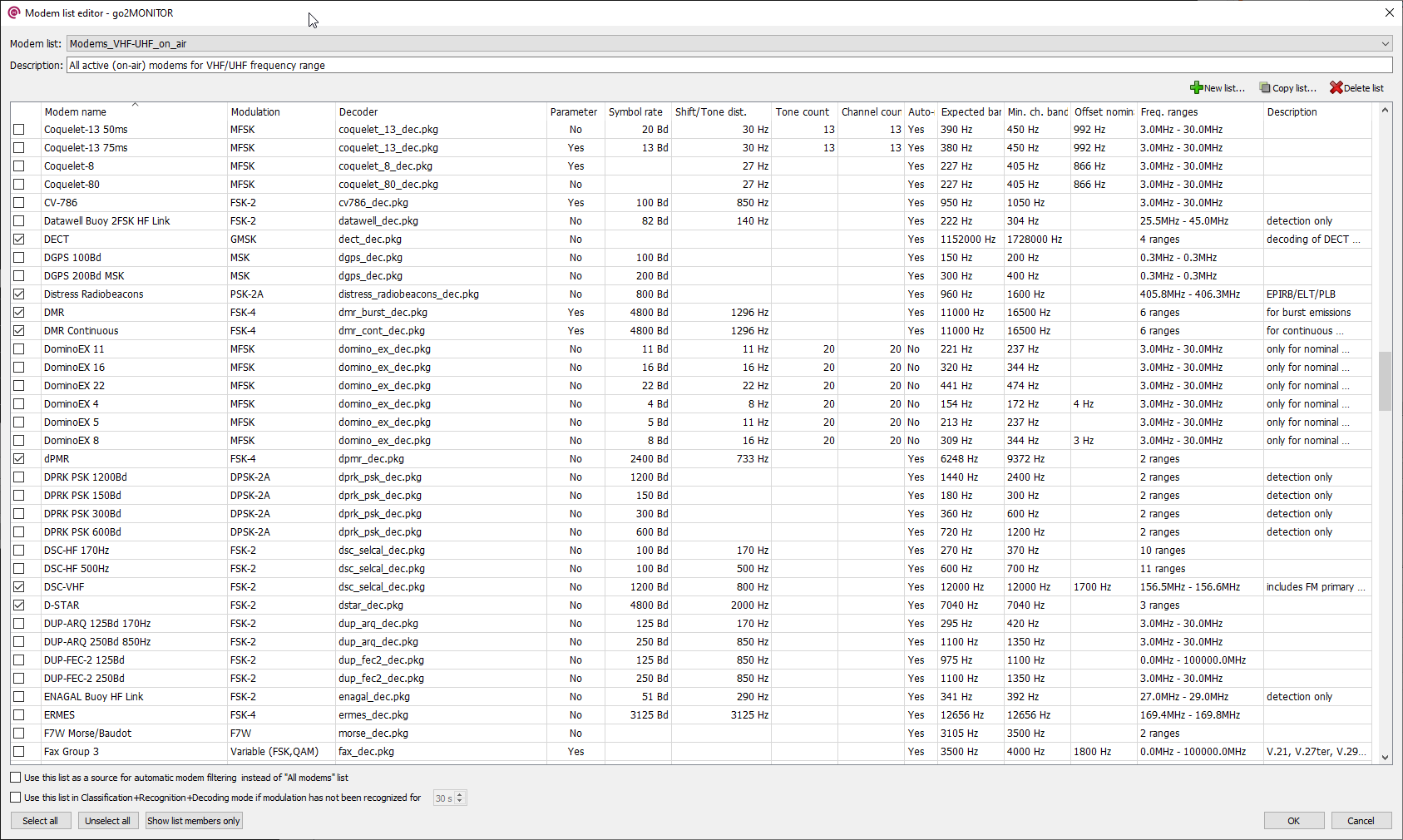
The software offers one of the largest and most current collection of COMINT modems worldwide, with more than 370 modems.
NEW DEMODULATOR FEATURES
-
PSK data aided: improved robustness of clock recovery
- New adaptive blind equalizer „Instant solver“
- PSK 2,4,8,16 AB
- DPSK 2,4,8,16 AB
- QAMn (single channel only)
- ALE4G: new special demodulator
- FSK demodulators: removed obsolete oversampling modes
NEW DECODER FEATURES
- New decoder added
- ALE-4G - NXDN: improved performance of automatic key calculation (scrambler encryption)
- Recognition and extraction of compressed zip or bzip2 files in following decoders
- STANAG-4539
- STANAG-4539 HDR
- STANAG-4415
- DMR / DMR continuous
- do not discard data on failed checksum to help decoding some special signals
- parse GPS position data send from Alinco devices
- output of „idle“ in the decoder status per slot during idle signal phase
- decoding of downlink burst signals (non-continuous)
- decoding of UDP port 5016 (ETSI text messaging) improved
- CIS-36-50
- split sync sequence in actual sync and priority
- reduced false positive detection
- added variants with shift of 75Hz and 125Hz
- AIS: added decoding of inshore protocols
- CHN MIL 64FSK: improved frequency offset tolerance
- HFDL: update system table to version 52
- Link 11 SLEW: improved burst end detection
- VDL2: updated ground station list
- Decoder package: add Python version to error message if the Python version of the
decoder does not match
NEW DECODER DETECTION FEATURES:
- Thales HFXL
- HARRIS RF-5800 Digital Voice
- MAHRS
- PSK-8 2400Bd Data Modem 120ms
- CHN MIL 8PSK 1627Bd
- CHN MIL 32FSK
- CIS BPSK 1200Bd
- CIS Selcal FSK 150/200
- CIS-75 FSK 75Bd 200/250/500Hz
NEW DECODER DEVELOPMENT LANGUAGE (PYDDL) FEATURES:
- Decoder execution via python script: production memory does not have to be imported manually
- convert_symbols: keep metadata (optional)
- bitbuffer: removed obsolete bitwise functions
RECEIVER SUPPORT
The go2signals software is compatible with a wide range of hardware receivers and direction finders from various vendors on the market (see technical specification monitoring suite on www.procitec.com), including support for VITA49 and ExtIO standardized interfaces. With this release, we added the following new features:
- Plugins and libraries for many receivers were ported to 64-bit
- Rohde & Schwarz EM200 receiver is now supported
- SignalHound SM200 C receiver is now supported
Noteworthy Changes
- Added support for ’Classification Profiles’ to be able to adapt spectrum calculation properties
and wideband classification settings to specific frequency ranges or use-cases - Completely redesigned UI elements for selecting and manipulating UI perspectives
- Result XML Export/Import format changed to enable easier integration in other systems.
Old result exports cannot be imported anymore. - Application Settings dialog redesigned to better separate UI settings from System settings.
In distributed systems, all system settings are now stored in the system itself, providing that UI does not have to be started in order to apply the settings. - New option for audio demodulation in ResultViewer to enable playback of the signal part
related to the selected result only, instead of playing the whole signal from the beginning. - Audio demodulation in ResultViewer now considers detected nominal frequency as default audio frequency even if auto mode is not used.
- String filtering in ResultViewer can now be parameterized to be case insensitive
- Standalone ResultViewer (go2MONITOR Result) now includes map server settings in its settings dialog
- The last state of the ’Show only rows with data’ option in a context menu of the ResultDetail
in ResultViewer is now stored permanently. - go2MONITOR Result (ResultViewer standalone) now includes a commandline interface to automate its operations by using Python-API, similarly as in go2MONITOR UI
- Python based Commandline options of the UI have been improved and better documented in the manual.
- Post-processing for ADS-B signals is now included, including extraction and display of aircraft positions.
- Clear filter function in ResultViewer can now be customized by the user to define which filter settings will be applied if the filter is cleared.
- Application settings now include an option to determine if the frequency selected in the channel in Decoding mode will be considered as nominal or center frequency
- In Result Export in Scheduler, user can now specify which flag should be used to mark results which has already been exported. That enables using multiple scheduler Result Exports at the same time on the same data.
- Auto-zoom function of the map component now uses system position as default position and uses improved logic
- New map display options in ResultViewer, Table view. It is now possible to display sender positions with fading effect to visualize their order (for example, sender movement), or without labels, to make sure that markers are not covered by labels.
- Function ’Open directory’ for single files inside Result Detail, now highlights that file in the
opened Explorer window. - Signal file name is now stored into the Source field in the database for all results from that file, if the file was used as channel input. This function was available only in Bulk File Processing in previous versions.
- UI will now close automatically if there is no connection with the system after 5 minutes
- Removed obsolete ’CIM export’ function
- Find emissions’ function renamed to ’Classify’
- Base station coordinates are now extracted from HFDL/VDL2 decoder results and stored in the database as sender positions in case of base station signals
- Because of modulation name changes throughout the product, some old AMT task exports may not be compatible with this version anymore. This will be the case if Modulation type trigger was used, involving specific voice modulation selection (AM, USB, ...) or FM-Radio modulation type.
What does the new version mean for you?
You have ...
... a valid update service contract?
Then you get a new update delivered once a year.
... another previous version of the software?
Now is the right time to get back into it. We will be happy to help you: sales@procitec.de
... interest, but are not yet a customer
Let’s start with go2signals, ask for your trial version: sales@procitec.de
FAQ about the update
Can I update?
Customers using go2signals 24.1 (go2MONITOR 24.1 / go2DECODE 24.1/ go2ANALYSE 24.1) are able to update their instance directly to version 24.2. Also, older versions can be updated; in this case please contact us to discuss your individual solution: sales@procitec.de
Will my data and customizations be preserved?
On a standard update your data will be preserved. If you have made customizations in function and design, we recommend that you check them in advance. If you need consulting or support we are happy to prepare a suitable offer for you: sales@procitec.de
What are the benefits of an update?
There are many benefits. You can find out which ones are specifically important for you while reading the following pages and discuss with us afterwards.
Why are updates generally useful?
The signal world is constantly changing. Updates guarantee that you keep up with the times. In addition to new features, our updates also bring optimization. The optimizations positively effect the speed, the security and the stability of the software. Additionally, updates maintain compatibility with host Operating-Systems’ patches and updates, assuring stability of the latest versions of components such as Python etc.



